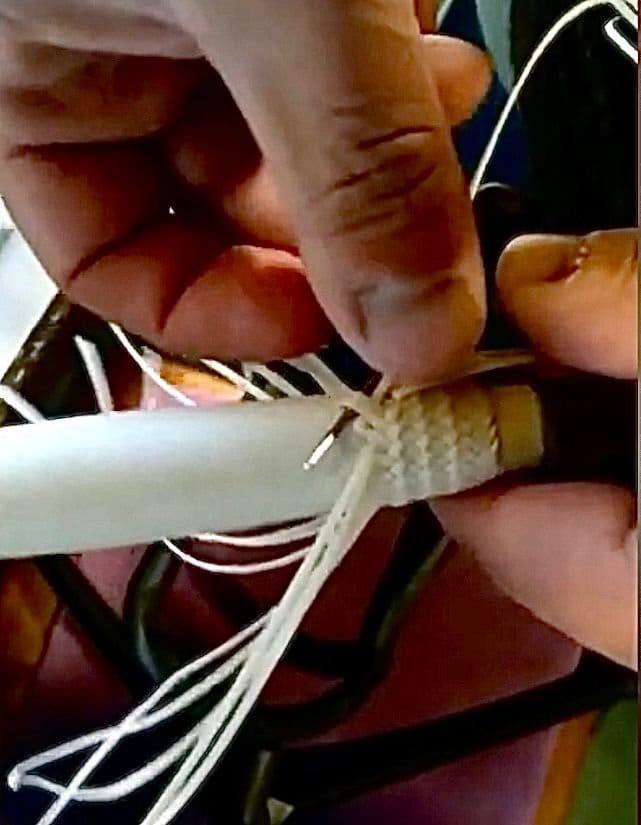The gaucho knife is an iconic symbol of Argentine culture, particularly revered in the Pampas region. These knives are not only tools but also works of art, often passed down through generations. One of the most distinctive features of gaucho knives is their handles, often wrapped in intricately braided leather, known as “tientos.” This article delves into the meticulous craftsmanship involved in making these unique knives.
Materials and Preparation0 of a Gaucho Knife
The creation of a gaucho knife with a braided leather handle begins with selecting high-quality materials. The blade is typically made from stainless steel or carbon steel, ensuring durability and sharpness. The handle core, often wood or metal, provides a sturdy base for the leather braiding.
Leather strips, or tientos, are prepared from cowhide, which is both strong and flexible. The hide is carefully cut into thin strips, ensuring uniform width and thickness. These strips are then soaked in water to make them pliable for braiding.
The Handle Braiding Process for a Gaucho Knife
[/et_pb_text][et_pb_video _builder_version=”4.23.4″ _module_preset=”default” global_colors_info=”{}”][/et_pb_video][/et_pb_column][/et_pb_row][et_pb_row _builder_version=”4.23.4″ _module_preset=”default” global_colors_info=”{}”][et_pb_column type=”4_4″ _builder_version=”4.23.4″ _module_preset=”default” global_colors_info=”{}”][et_pb_video src=”https://www.youtube.com/watch?v=w2G17GC20G4″ _builder_version=”4.23.4″ _module_preset=”default” global_colors_info=”{}”][/et_pb_video][/et_pb_column][/et_pb_row][et_pb_row _builder_version=”4.23.4″ _module_preset=”default” global_colors_info=”{}”][et_pb_column type=”4_4″ _builder_version=”4.23.4″ _module_preset=”default” global_colors_info=”{}”][et_pb_text _builder_version=”4.23.4″ _module_preset=”default” global_colors_info=”{}”]
The art of braiding leather handles is a skill passed down through generations of craftsmen. It requires patience, precision, and a keen eye for detail. The process begins by securing the tientos at one end of the handle core. Craftsmen use various braiding techniques, each producing a unique pattern and texture. Some of the most popular braiding styles include:
- Simple Braid: This basic style involves intertwining three or four leather strips in a straightforward pattern. It’s often used for functional knives where simplicity and durability are key.
- Herringbone Braid: This more complex pattern involves weaving multiple strips in a diagonal, crisscrossing manner. The result is a striking, textured handle that provides a comfortable grip.
- Basketweave Braid: This intricate style creates a checkerboard effect by weaving the strips over and under each other. It’s a highly decorative braid, often used on ceremonial or display knives.
Each braid is tightened meticulously to ensure the leather sits snugly against the handle core. This not only enhances the knife’s appearance but also ensures a secure, ergonomic grip.
Finishing Touches
Once the braiding is complete, the leather is allowed to dry and set in place. Any excess tientos are trimmed, and the ends are securely fastened, often with decorative knots or metal ferrules. The handle is then treated with oils or waxes to enhance its durability and luster.
The final step involves polishing the blade and sharpening it to a fine edge. Craftsmen often engrave intricate designs or symbols onto the blade, adding a personal touch and further enhancing the knife’s aesthetic appeal.
A Symbol of Heritage
Gaucho knives with braided leather handles are more than just functional tools; they are a testament to the rich cultural heritage and craftsmanship of Argentina. Each knife tells a story, reflecting the skills and traditions of the artisans who create them. Owning a gaucho knife is akin to owning a piece of Argentine history, a symbol of the rugged yet refined spirit of the gauchos who once roamed the Pampas.
In conclusion, the making of a gaucho knife with a braided leather handle is a labor of love, requiring skill, patience, and an unwavering commitment to quality. It is a craft that has stood the test of time, preserving a vital piece of Argentine culture for future generations to appreciate and cherish.
Visit our entire knife collection – Click Here
